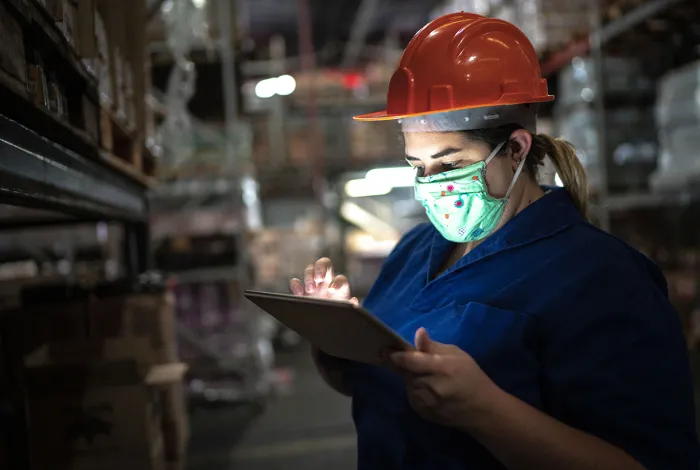

Now Available!
Get your copy of the 7th Annual State of Smart Manufacturing and hear from 300+ manufacturers in this new survey report!
Subscribe to Our Blog
For a monthly digest of expert insights, data points, and tips like the ones in this article.
Why IIoT Serves a Critical Role During the COVID-19 Pandemic
Industrial Internet of Things (IIoT), COVID-19 (Coronavirus)
The beginning of the year 2020 marks a once-in-a-lifetime health and economic event. The World Economic Forum says the economic fallout has the capacity to be on par with the Great Depression. Most experts agree that we have a long road ahead of us to ensure that future interactions will not compromise our health and safety. The likelihood of organizations being forced to operate with significantly less staff until a vaccine or a cure is discovered is a reality that companies are preparing for.
In this new reality, manufacturers have been forced to adapt to having limited staff on the plant floor while trying to ensure greater access to data and control remotely. The Industrial Internet of Things (IIoT), a connected solution designed to provide increased visibility, holds remarkable power to enable remote condition monitoring, maintenance instructions, production monitoring, and tracking quality.
Condition Monitoring and Maintenance
One of the first use cases that customers consider for IIoT is remote condition monitoring and predictive maintenance. With IIoT tracking plant floor maintenance, personnel can monitor assets remotely for unusual behavior. A maintenance technician can set multiple thresholds, alarms and subscribe to notifications that will alert them for any plant floor issues. All of this can be achieved while working from home and having only essential people on the plant floor.
Furthermore, IIoT can enable remote instruction delivery to people on the plant floor from remote maintenance personnel. This can include instructions to replenish coolant in the milling machine or adding lubricant to the stamping press gearbox before proceeding forward. Third-party machine and reliability experts can be looped in for consultation by remotely sharing process and failure data for advanced guidance. If in-person support is required, the maintenance technician can schedule the fix when personnel on the floor are away or over the weekends to minimize the impact on production.
Production Monitoring
When the economy is down and consumption is flattening, causing organizations to operate with a limited workforce, they can stay competitive by improving production efficiencies. IIoT can enable production planners and supervisors to monitor OEE (Overall Equipment Effectiveness), production rate, scrap, part count, and cycle times while operating remotely. They can adjust the production target rates based on continuously evolving market demand. With continuous production monitoring, waste can be controlled while maintaining optimal production rates. Additionally, production supervisors can be notified if OEE drops below a particular threshold, or scrap count increases. All of this can be done remotely.
Quality and Traceability
Product quality remains paramount during an economic downturn as manufacturers must differentiate themselves to survive today and grow upon recovery. A single quality incident can affect manufacturers credibility in the market. Each part needs to be checked thoroughly, and processes should be tuned to limit waste. Sampling processes should be rigorously enforced to ensure product conformance. For mass-produced parts, quality checks and production recipe tracking in manufacturing is performed manually. With limited workforce having to abide by social distancing demands, maintaining the volume and velocity of these manual checks can become a daunting task for organizations.
With IIoT, however, quality managers can get a direct feed of machine process data for each part that is manufactured. Parameters such as machine temperature, vibrations, cutting tool processing, part operations, time, and machine upon which the piece was built, and operator data can be delivered to quality supervisors in the safety of their homes. If any quality incidences are detected after the production run, IIoT logs can enable process traceability. Supervisors can analyze the data to tweak the processes to avoid reoccurrence and efficiently produce high-quality goods.
For the foreseeable future, safe and more remote operations will remain a priority. Yet manufacturers must stay apprised of plant floor operations remotely and cannot compromise quality. Automation technology like IIoT will help reduce the strain on manufacturers while enabling key production activities such as condition monitoring, efficiency management, and quality traceability.

